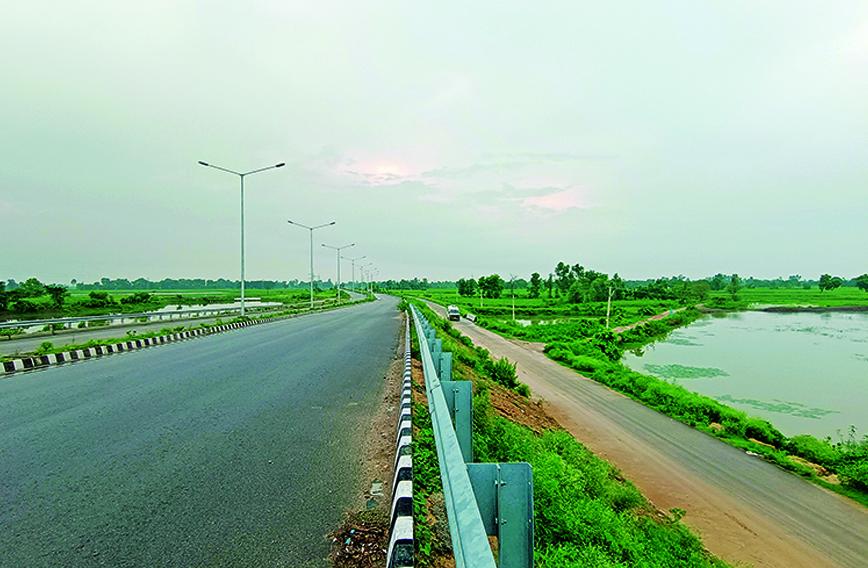
VENKATESH DUTTA
When highways get built, they traverse many water bodies which feed rivers and streams and may in fact be more important than roads for the prosperity and well-being of a region, especially in drought-prone areas.
Highways of course play a crucial role in facilitating transportation and fostering economic activities, but their adverse effect on freshwater systems should be taken into account at the time of planning and design. Not doing so has negative consequences that cannot be reversed.
Earth has an extensive network of man-made roads, spanning an impressive 63.69 million kilometres. It is projected that several million more kilometres will be added to this network by 2050. Among countries with the largest road networks, India stands second only to the United States.
Recently, I travelled to Lakhimpur Kheri to survey the wetlands that serve as the origin of the 760-km Sai river — a tributary of the Gomti. The source wetland is called Panai Jhabar. I was disappointed to see the whole wetland fragmented into parts due to the construction of the highway that connects Shahjahanpur and Lakhimpur. Consequently, the wetland has significantly diminished in size, primarily due to the loss of crucial watersheds that used to feed the Sai.
Similarly, in Lucknow, Kisan Path — a circular road circumferencing the entire district — is being made. Our researchers were trying to restore the 28-km Kukrail river in Lucknow. It is a very important drainage system of the city. Now the problem is how to connect the upper reaches with the lower stretch of the river as the carriageway width of Kisan Path has blocked the drainage near the origin of the river. The natural flow of water has been intercepted by the road. As a result, upstream villages are at a higher risk of flooding during the rainy season, while downstream portions of the river may dry up as the flow gets cut off. Many new infrastructure projects are adding to the water woes of the city.
The periodic floods in Gurugram during rains can be attributed to the severe disruption of the natural drainage system caused by the construction of roads and permanent concrete structures on the wetlands. The city has experienced the disappearance of several water bodies. This has resulted in the impairment of the city’s ability to effectively manage and channel excess water, exacerbating the flooding situation during rainy periods. Some water bodies and their channels were also impacted by the 60-km DND-Faridabad-Ballabgarh bypass-KMP Interchange section of NH 148NA.
In a Public Interest Litigation (PIL), it was alleged that the contractors hired by the Tamil Nadu Road Development Corporation (TNRDC) for the Old Mahabalipuram Road (OMR) Phase II project were causing destruction to the Kalleri and Padur lake pond, located near Chennai. In response to this issue, Madras High Court provided valuable advice to the Tamil Nadu government, urging it not to encroach upon water bodies and pathways under the pretext of development projects.
When the construction of roads and highways reduces wetland areas, it leads to siltation and reduction in groundwater recharge. If there is to be any change in the drainage pattern after the construction of a highway, details of changes should be delineated. Environmental Impact Assessment (EIA) has been established as a mandatory step to obtain environmental clearance for highway projects. However, the natural drainage system that exists prior to road construction is often overlooked by the planners. Consequently, vital aspects of the pre-existing drainage system, which play a significant role in maintaining the ecological balance, are not thoroughly studied and considered in the decision-making process. This oversight can lead to adverse consequences on the environment and surrounding ecosystems.
Generally, a culvert, syphon or bridge is constructed on a rivulet or river. But in the rush to construct highways, and to cut the cost, such structures are not always made. This results in loss of streams as well as flooding. When a road is planned to pass through a floodplain of a river, it is crucial to provide detailed information regarding micro drainage, flood passages, and the frequency of floods in the area. Understanding the micro drainage patterns helps identify natural water flow paths and ensure that the road construction does not disrupt them.
During road construction, it is crucial to ensure proper drainage of accumulated water. When a road is built on natural terrain, it intercepts the natural waterways, necessitating the implementation of measures to divert the water to lower stretches without disrupting the existing streams. Designing effective drainage systems is paramount, and it is essential to ensure that the inlets of drains are sufficiently large to facilitate the smooth flow of water. Thorough study of drainage catchment areas and existing drainage systems should be conducted as a preliminary step in highway planning. Additionally, aqueducts, culverts, and other cross-drainage structures have to be constructed wherever necessary to accommodate and facilitate the passage of rivulets or streams that intersect the highway’s path. These measures collectively contribute to proper water management and the preservation of natural water flow patterns during road construction.
Indeed, the alignment of a road plays a crucial role in addressing drainage issues. Surveys and investigations, particularly hydrological surveys, are of utmost importance in the design of highways. These surveys involve assessing factors such as rainfall patterns, estimating run-off, gathering information on high flood events, and acquiring knowledge about the presence of wetlands and streams in the region. We must minimize the impact of the road on the natural water flow and ecosystems. ν
Venkatesh Dutta is a Gomti River Waterkeeper and a professor of environmental sciences at Ambedkar University, Lucknow
Comments
Currently there are no Comments. Be first to write a comment!




